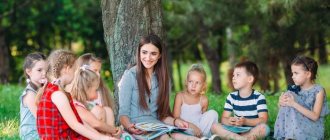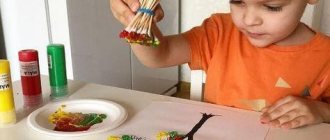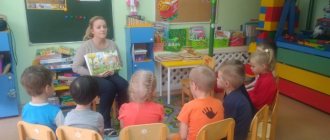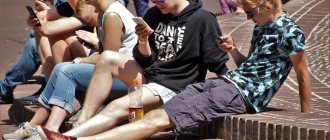Project activities as a means of introducing preschoolers to fiction.
Modern education is at a new stage of development - it is being modernized. In this regard, the educational institution is focused on a creative, successful person, so updating the content of preschool education, technology and quality systems is natural.
Introducing the younger generation to literature is one of the priorities of modern education. Reading works of literature is considered today as an essential element of culture. Meanwhile, a number of negative trends in the field of children's literature and children's reading have recently emerged. The active introduction of computer and information technologies into a child’s life reduces the status of literature, and the share of reading in the structure of children’s free time is sharply reduced.
Parents who read are role models. But at present the family is in a state of crisis, and due to a number of objective reasons its influence on the formation of a child reader is difficult. This process is facilitated by the lack of proper attention to the process of developing the child’s reading interest on the part of the father and mother. Children have little in common with books, and this is reflected primarily in their intelligence, literacy, moral and emotional development.
Through fiction, we introduce the child to the values without which the spiritual life of society and the individual is impossible. Currently, this is very important, since society is experiencing a moral and moral crisis.
The Federal State Educational Standard for Preschool Education includes the task of familiarizing preschoolers with book culture in the educational field of speech development, the main goal of which is to develop children’s interest and love for books, and to educate future readers [2, clause 2.6. Federal State Educational Standard DO].
Based on this, we can conclude that the state and society have put forward requirements for introducing students to fiction, but in practice it is impossible to fully introduce them, since:
- the child shows no interest in fiction;
- the child is careless with the book;
- there is no system in working to introduce preschoolers to fiction;
- indifference on the part of parents to the process of introducing preschoolers to fiction.
This problem requires an immediate search for a solution, since fiction is the basis on the path to knowledge. In our kindergarten, much attention is paid to project activities, which, of course, is one of the effective ways to solve this problem, because it is in project activities that such important principles as cooperation between the teacher and children and the principle of joint development are combined. Another important detail is that it is the method of project activity that gives children the opportunity to independently acquire and synthesize acquired knowledge, develop creative abilities, and communication skills. Another undoubted advantage of this method is that it allows parents of preschoolers to be involved in and reveal the values of joint creativity with their children, as well as increase their competence in introducing preschoolers to fiction.
From the work experience of teachers at MBDOU “Kindergarten No. 397” g.o. Samara: Passport of the project “In the World of Fairy Tales”
Project title : “In the world of fairy tales.”
Type of project: educational - creative.
Project developer : Efremova Natalya Aleksandrovna, Mukhankina Yulia Viktorovna, Pulargina Anzhelika Sergeevna, Surikova Olesya Vitalievna
Project participants: educators, preschoolers, parents.
Project duration: 3 months
Problem : Lack of interest in reading fiction.
The goal of the project : introducing preschoolers to fiction, educating the future reader.
Main goals:
- introduce children to a variety of different literary genres (fairy tales, stories, poems), folklore works (counting books, nursery rhymes, chants, lullabies, riddles, proverbs, etc.)
- cultivate the need to communicate with books, a culture of reading, and respect for books.
- develop children's speech, expand their horizons and vocabulary.
- involve children in speech, music, art, and play activities related to the image structure and plot of a fairy tale;
- develop memory, imagination, attention;
- form an emotional response to literary works.
Forms of work on the project:
With kids:
- reading and viewing fiction;
- conducting didactic, verbal, role-playing games with children;
- dramatization of fairy tales with children;
- conducting GCD;
- independent visual activities based on fairy tales (drawing, coloring, modeling, appliqué).
With parents:
- familiarization with consultations, recommendations, advice;
- Involvement in participation in creative work carried out jointly with children.
Expected results:
Metasubject:
- Cognitive:
- the preschooler is familiar with works of children's literature;
- children have an idea of what and how books are made, what great value they have for understanding the world;
- the cognitive interest of preschoolers is formed;
- the vocabulary of preschoolers is enriched;
- Children have a fairly good command of oral speech.
2. Communication:
- the child has developed a stable interest in books and fiction;
- preschoolers have developed the ability to coherently, consistently and expressively retell short fairy tales and stories;
- Every child is involved in creative activities.
3. Regulatory:
- the child understands that books must be taken care of.
4. Personal:
- a preschooler shows initiative and independence in various types of children's activities, play and communication;
- preschoolers have formed an emotional attitude towards literary works;
- Children are emotionally developed, able to empathize, and inquisitive.
Result, product of project activity: production of a tabletop puppet theater, drawings, crafts, appliqué work.
Development prospects:
- introducing preschoolers to various works of fiction and folklore;
- introducing preschoolers to fiction;
- enriching the “reading experience” of children through works of various genres of folklore (chants, fables, counting rhymes, fairy tales), literary prose (stories with moral overtones) and poetry (author’s riddles) - expanding children’s horizons;
- increasing parental competence in introducing children to fiction;
Stage 1: Preparatory:
- Conduct a survey of children “Through the pages of fairy tales”;
- Questioning parents “The role of fairy tales in raising children”;
- Defining the topic, purpose, content of the project;
- Select sources of information
- Set certain tasks.
- Determine the project timeline.
Search for materials on this project topic. Selection of fiction. Selection of illustrative material on the topic of the project. Learning poems about animals and fairy tale heroes. Selection of information material for the parents' corner. Development of notes on cognitive, speech and creative knowledge. Selection of board and printed games, finger games, didactic games, figurines of fairy tale heroes. (2 weeks. During regime moments.)
Stage 2: Practical activities:
- Conversations “What fairy tales do I know”; acquaintance with Russian folk tales (“Teremok”, “Ryaba Hen”, “Rukavichka”, “Fox with a rolling pin”, “Three Bears”)
- Examination of illustrations for fairy tales;
- Organization and conduct of modeling classes: “Modeling fairy tale heroes” - examination of illustrations for fairy tales;
- Organizing and conducting classes in modeling “Treats for the animals”, “Logs for the tower”, “Forest and garden apples”;
- Organization and conduct of drawing classes - non-traditional drawing - “Tree of Friendship” (blotography); decorative drawing" Decorate the mitten", "Beautiful rolling pin for the fox";
- Dramatization of Russian folk tales at the request of children;
- Construction: “Beds for three bears, “Teremok for animals”, “House for Ryaba’s chicken”
Musical activity: Learning songs from fairy tales
Game activity: “Correct the mistake.” Goal: to develop the ability to reconstruct events sequentially from present pictures. oven game “Fairytale Lotto”, “Tale after Tale”, “Fairytale Carousel”, “Geese-Swans”, “At the Bear in the Forest”.
—Memorization of folklore works (proverbs, chants, counting rhymes, tongue twisters, etc.).
- To develop the ability to evaluate the actions of fairy-tale characters
- Develop memory, imagination, attention.
- Cultivate a love of fiction.
- Cultivate a desire to listen and remember fairy tales.
- Cultivate a sense of empathy and kindness.
- Develop skills in handling books carefully.
Maintain interest in dramatizing favorite fairy tales. Learn to convey the structure of a fairy tale using modeling. To develop the moral qualities of preschoolers. To develop interest in theatrical and play activities. (3 months During regime moments.)
Stage 3. Working with parents:
- Consultation “The role of fairy tales in the education of preschool children”;
- Visual and informational cooperation “What and how to read to children at home”;
- Conducting a parent meeting using ICT technologies: “Family reading to children”;
- Drawing competition “My favorite fairy-tale hero.”
Joint creativity with children: making “baby books” based on their favorite fairy tales. (3 months).
Stage 4 Final.
Project results: Production of a tabletop puppet theater; Exhibition of drawings; Exhibition of “baby books”.
To summarize, I would like to note that project activity in the process of introducing preschoolers to fiction is a fairly successful method of activity for our teachers. Positive results were noted. The level of development of interest in fiction on the part of preschoolers has changed positively.
Children began to show interest in listening to literary works more often. With great pleasure, the preschoolers began to analyze the text, answering questions about the work they had read. Children began to take more active part in games - dramatizations of works of art based on text, to show creative initiative in reproducing the plot, creating images of heroes.
Children successfully master the program material, use the acquired knowledge, skills and abilities in direct educational activities, educational activities during routine moments, and in independent activities. The vocabulary of preschoolers has been enriched. Children develop a sufficient level of dialogic and monologue speech, which parents readily note. Preschoolers have become more emotionally responsive, friendlier, and more inquisitive. Children began to treat books more carefully. In conclusion, I would like to note that no one has ever been given a love for a book from birth, therefore, in order for a child to fall in love with it, a lot of serious work is needed.
Literature: 1. Ushakova O. S. Introducing preschoolers to fiction. - M.: Publishing house. Litera, 2012. 2. Kurbatova S. I. Experience of gender education of children through exposure to fiction / S. I. Kurbatova // Preschool pedagogy. - 2012. - No. 3. 3. Obnosova Kh. A. Introducing children to fiction in modern society // Culture and education. - May 2015. - No. 5. 4. Migunova E. V. Theatrical pedagogy in kindergarten. - M.: TC Sfera, 2009. Kiseleva L. S. Project method in the activities of a preschool institution: a manual for managers and practical workers of preschool educational institutions / 5th ed., revised. and additional - M.: ARKTI, 2010 - 95 p. 5. Solodyankina O. V. Design system in a preschool institution: a methodological manual. - M.: ARKTI, 2010 - 78 p. 6. Veraksa, N. E. Project activities of preschoolers: a manual for teachers of preschool institutions / N. E. Veraksa. - M.: Mozaika-Sintez, 2014. 7. Veraksa, N. E. Approximate general educational program for preschool education “From birth to school” / N. E. Veraksa. - M.: Mozaika-Sintez, 2022. 8. Law of the Russian Federation on Education. Order of the Ministry of Education and Science of the Russian Federation (Ministry of Education and Science of Russia) dated October 17, 2013 No. 1155 Moscow 9. “On approval of the federal educational standard for preschool education.” The concept of spiritual and moral development and education of the personality of a Russian citizen. 10. website of the Ministry of Education and Science of the Russian Federation. 11. website of the Ministry of Education and Science of the Samara Region.
Author: Mukhankina Yu.V.
Photos: Pexels
Tags:Books by Mukhankin Yu.V. Preschool experience Social and communicative development
Creative project to create the artistic and aesthetic development of children “Shadow Theater”
author:
Vinyukova Irina Viktorovna
Teacher of MBDOU Kindergarten No. 42 "Malinka" Stary Oskol, Belgorod region
Bozhkova Svetlana Vladimirovna
Teacher of MBDOU Kindergarten No. 42 "Malinka" Stary Oskol, Belgorod region
Creative project to create the artistic and aesthetic development of children “Shadow Theater”
Creative project to create artistic and aesthetic development of children
"Shadow play"
Completed:
Vinyukova I.V.
Bozhkova S.V.
Brief summary of the project:
Artistic and aesthetic development" involves the development of prerequisites for the value-semantic perception and understanding of works of art and the natural world:
- the formation of an aesthetic attitude towards the surrounding world;
- formation of elementary ideas about types of art;
- perception of music, fiction, folklore;
- stimulating empathy for characters in works of art;
- implementation of independent creative activities of children (visual, constructive-model, musical, etc.).
).
Artistic and aesthetic activity is an activity specific to children, in which a child can most fully reveal himself, his capabilities, feel the product of his activity (drawings, crafts) and, in a word, realize himself as a creative person.
The main goal of the teaching staff of the preschool educational institution is to develop the child’s creative potential and create conditions for his self-realization.
To obtain the expected results, a system of work on artistic and aesthetic education has been created in a preschool institution, which consists of interconnected components:
- updating the content of education (choice of programs and technologies);
- creation of conditions for aesthetic education (staffing, educational and methodological support, creation of a subject-development environment);
- organization of the educational process (work with children and parents);
- coordination of work with other institutions and organizations.
This system of work involves close cooperation between the young teacher and all preschool specialists (psychologist, music director, visual arts teacher, psychologist, kindergarten head, senior teacher, teacher-mentor).
Each employee assumes certain functional responsibilities in the field of artistic and aesthetic education. Purposeful and coordinated activities of all specialists are achieved through joint planning of the educational process.
Children's shadow theater is not just a type of game for a child - it is an additional way of his development. Playing with shadows stimulates the baby's imagination and develops his imagination. Obtaining certain characters here is possible, for example, by folding your fingers in a certain way. Accordingly, this provides additional opportunities for developing the child’s manual dexterity and coordination of his movements. At the same time, if we are talking about an early age, then the performance can be organized by the child’s parents.
Older children are already able to take part in the performance themselves. For group activities it is also possible to use a shadow theater. In kindergarten, these entertainments are often used as exercises to develop the child’s motor skills and speech. And text accompaniment, in turn, stimulates the speech culture of children.
Project type:
creative, long-term, group.
Project participants:
children of the younger group and their parents; educators.
Project implementation timeline:
May 2022 to May 2022.
Relevance:
One of the most effective means of developing and educating a child in early preschool age is theater and theatrical games, because Game is the leading type of activity for preschool children. And theater is one of the most democratic and accessible forms of art, which makes it possible to solve many pressing problems of pedagogy and psychology related to artistic and moral education, the development of personal communicative qualities, the development of speech, imagination, fantasy, initiative, etc.
Children learn to notice interesting ideas in the world around them, embody them, create their own artistic image of a character, they develop creative imagination, associative thinking, and the ability to see unusual moments in the ordinary.
This activity develops the child’s personality, instills a sustainable interest in literature, music, theater, improves the skill of embodying certain experiences in play, encourages the creation of new images, and encourages thinking. Theater is one of the most democratic and accessible forms of art for children; it allows solving many pressing problems of modern pedagogy and psychology.
In addition, collective theatrical activities are aimed at a holistic impact on the child’s personality, his emancipation, involvement in action, while activating all his capabilities; for independent creativity; development of all leading mental processes; promotes self-knowledge and self-expression of the individual with a fairly high degree of freedom.
Objective of the project:
To create conditions for self-realization of a young teacher in the field of artistic and aesthetic development of children.
Tasks:
- to develop children’s interest in theatrical and play activities;
- introduce a new type of theater - shadow;
- develop artistry and communication.
Project implementation forms:
- reading children's fairy tales;
- looking at illustrations for fairy tales;
- didactic games;
- entertainment (shadow theater games);
- conversations.
Expected results of the project:
In the course of implementing the tasks of raising and developing theatrical activities in a child, it is assumed that children will acquire:
- the required minimum knowledge of fairy tales;
- desire to read new fairy tales;
- will learn to find their reflection and ideas about the world around them and their attitude to a particular problem situation;
- master shadow theater skills;
- will develop creative potential.
Brief description of the project by stages.
Theater activities:
didactic games, games in various types of theater, performances of fairy tales using plane figures, entertainment “Seasons”.
Reading fiction:
reading children's folk tales, reading children's original fairy tales
Socialization:
conversations about types of theater, conversations on the topics: “Who is an actor”, “Who is a make-up artist”, “Who is a decorator”, looking at illustrations for fairy tales, watching videos of shadow theater
Cognition:
didactic games “Count the shadows”, “Find a larger or smaller shadow”, “Find a narrower or wider shadow”, “Find a similar shadow”.
Ecological development - looking at shadows while walking. Didactic games: “Find the shadow of a tree or bush”, “Create your own shadow”. Conversations: “Is there shadow on a cloudy day”, “Is there shadow in winter”...
Experiments: “Make a shadow from a twig, a shovel, a bucket...”
Communication:
replenish children's vocabulary with vocabulary related to the art of theater, retelling fairy tales, telling fairy tales by role, telling fairy tales of one's own composition.
Artistic creativity:
drawing shadows (shading on stencils with black or a simple pencil), coloring books based on fairy tales.
Music:
listening to music for fairy tales, playing musical instruments during performances of fairy tales.
Physical development:
improve children's skills in creating images of wildlife using their hands for shadow theater.
Working with parents:
article for parents in the group newspaper “The role of theatrical activities in the development of preschool children.” An article for parents in a group newspaper: “Chinese Shadow Theater.” An article for parents in a group newspaper: “Home shadow theater.” Replenishment by parents of the material base for theatrical activities in the group. Parents replenish the library with fairy tales in the group. Participation of parents in the production of various planar figures together with children for playing them in a shadow theater
Group work:
production of a set of planar figures for showing various fairy tales in a shadow theater, production of didactic games.
Stages and activities of the project implementation.
- stage. Preliminary work:
- selection of literature, paintings, illustrations, preparation of presentations;
- replenishment of the theater corner;
- announcement to children and parents about the start of the project;
- creating a high-quality subject-development environment to expand children's understanding of the theater, its types, attributes, costumes, and scenery.
- stage. Project implementation:
| Joint educational activities | Organization of the environment | Working with parents | |
| Cognitive development | Conversation « Fairy-tale heroes" ; « Favorite fairy tales"; “Do children like puppet theater?” “What is theater?” Looking at illustrations for fairy tales. Problem situation “Why is the bun round?”, “What would happen if the bun turned out to be square?” D/s based on fairy tales: “Who is hiding in a fairy tale?”, “Find out by the contour”, “Who is behind whom?”, “Find a couple”, What (who) is missing?”, “Find the artist’s mistakes”, “From which fairy tales?". Puzzles based on fairy tales, games with cubes “Assemble a fairy tale.” Experimentation: What can you make an egg out of so that it doesn’t break like in a fairy tale? (natural egg, shell, clay, plasticine, paper, wood......). Design: house for the heroes of the fairy tale “Teremok”. Hide seven kids behind a high fence. Let's help the piglets build houses. | Plot pictures, illustrations for fairy tales. Tabletop theaters: “Turnip”, “Ryaba Hen”, “Teremok”; theater on flannelgraph: “Zayushkina’s hut”, “Kolobok”. Replenishing the experimentation corner with materials for the experiment (natural egg, shell, clay, plasticine, paper, wood......). | Invite parents to take part in the creation of the mini-museum “Teddy Bear”. Oral survey “Do you play theater with your child” (at the beginning and end of the project). |
| Social-communicative development | Communication activities : a game that imitates the images of well-known fairy-tale characters (a clumsy bear walks towards the house, a brave cockerel walks along the path). A single-theme dramatization game with several characters based on folk tales (“Kolobok”, “Turnip”) and author’s texts (V. Suteev “Under the Mushroom”, K. Chukovsky “Chicken”). Mimic gymnastics “Show your mood if.....”. The game is a dramatization of “Teremok”. C/i: “Hairdressing salon (dressing room)”; "Let's go to the theater." Self-service and basic household work: game situation “Mishutka doesn’t know how to hold a spoon”, Help the artists put things in order in the costume room. | Mini stage with microphone. Rubber Toy Theater, costumes for the fairy tale “Turnip”, “Teremok”. | Individual conversations, consultations with parents to identify their interest in replenishing the theater corner, their abilities in one or another area of handicrafts and opportunities. |
| Speech development | Modeling fairy tales using mnemonic tables. Voice imitation games: “Who screams?”, “Who gives their voice?” ... Learning tongue twisters. “One, two, three repeat” D/i Wonderful bag (heroes of which fairy tales) Role-playing dialogue heroes of fairy tales (“Rukavichka”, “Zayushkina’s hut”). R/i “Say a word.” Reading fiction: from quiet A. Barto “Toys”. P. Voronko “New clothes”. L. Tolstoy “Three Bears”, “Grandfather sat down to drink tea”. Russian folk tales “Kolobok”, “Mitten”, “Winged, shaggy and oily”, “Golden comb cockerel”. | Flannelograph. Creation of mnemonic tables. Fairy tales stories on the topic. | Memo “Games for the development of speech of children 3-4 years old. Recommend that parents read Russian folk tales at home with their children. |
| Artistic and aesthetic development | Visual activities: applique “Turnip”, “Let’s decorate Mashenka’s dress” (cone theater, applique on cones). Coloring pictures based on Russian folk tales. Drawing "Kolobok is rolling along the path" Modeling from salt dough “Pies for grandparents”, “Kolobok”. | Coloring pages based on the fairy tales “Teremok”, “Kolobok”, “Turnip”, “Ryaba Hen”. Salt dough of different colors. Molds for making pies. | Joint creativity with parents “My favorite fairy-tale hero”, “Animals in fairy tales”. |
| Physical development | Outdoor games with a plot: “At the Bear in the Forest”, “Shaggy Dog”, “Sparrows and the Cat”, “The Little White Bunny Is Sitting”, “Who Runs Faster to the Named Hero of the Fairy Tale”. Imitation exercises “Depict the hero of a fairy tale”, “Show how a bear, a fox walks...” | Masks for outdoor games. | Invite parents to make their own masks |
Stage 3. Presentation:
children show their parents a dramatization of the fairy tale “Teremok”. Organization of the mini-museum “Teddy Bear”.
Project results.
The maximum possible conditions have been created for the self-realization of a young teacher in the field of artistic and aesthetic development of children. Professional interest in educational activities with children has increased. The competent level in implementing assigned tasks in working with children has increased. The mechanism for the professional growth of a young specialist has been fully launched.
The children developed an interest in theatrical activities and a desire to participate in all theatrical events.
Children's verbal communication skills have improved. They began to emotionally read poetry and convey the image of heroes in fairy tales.
Bibliography:
Borodich A.M.
Methods for developing children's speech. M., 1981, Pakhomova O.N. Good fairy tales. M., 1999, Shchetkin A.V. Theatrical activities in kindergarten. For children 3-4 years old. M., Mosaika, 2008, 128 p. Creative project to create the artistic and aesthetic development of children “Shadow Theater”
MAGAZINE Preschooler.RF
Project “Artistic and aesthetic development of preschool children”combined kindergarten No. 3, Barabinsky district, Novosibirsk region
- Senior teacher: Yashchenko G.G.
- Musical director: Zakharova T.A.
Relevance of the project:
The most popular and exciting area in preschool education is theatrical activities. It is theatrical activities that make it possible to solve many pedagogical problems related to the formation of the expressiveness of a child’s speech, intellectual and artistic-aesthetic education. The purposeful formation of coherent speech through theatricalization is of utmost importance in the general system of speech therapy work with children. Theatrical games are performance games. In them, with the help of such expressive means as intonation, facial expressions, posture and gait, gesture, specific images are created. Thanks to theatrical games, children develop their emotional sphere, the experience of children’s cooperation expands and enriches, both in real and imaginary situations. In addition, theatrical activities contain enormous opportunities for correcting personal development. By participating in theatrical games, children become participants in various events from the lives of people, animals, and plants, which gives them the opportunity to better understand the world around them. At the same time, theatrical play instills in the child a sustainable interest in his native culture, literature, and theater.
The educational value of theatrical games is also enormous. Children develop a respectful attitude towards each other. They learn the joy associated with overcoming communication difficulties and self-doubt. For the successful implementation of knowledge, skills and abilities in speech development, musical and theatrical skills, we created a musical performance based on the fairy tale of the same name by K. I. Chukovsky “The Tsokotuha Fly in a New Way .
Goals:
- Development of interest in theatrical and musical activities;
- Creating conditions for active self-expression and development of children's creative abilities.
Integration of educational areas: speech development, artistic and aesthetic development, social and communicative, cognitive, physical.
Tasks:
- To promote the development of creative independence, aesthetic taste in conveying an image,
- Strengthen the ability to use means of expression (postures, gestures, facial expressions, intonations, movements),
- Develop clear pronunciation
- Activate your vocabulary.
- Improve children's coherent speech;
- To develop voluntary attention, memory, observation, imagination, speed of reaction, initiative, endurance, and the ability to coordinate one’s actions with partners.
- Continue to strengthen the ability to move expressively and rhythmically in accordance with the varied nature of music,
- Develop the ability to act in a theater group
Type of project: informational and creative, group.
Duration: 6 months.
Result: presentation of the project in the form of a musical performance.
Project implementation stages:
Stage 1: preparatory work.
- Defining the topic (project problems, setting goals for project activities, formulating tasks).
- Drawing up a project plan.
- Selection of materials and equipment for work.
- Collection of information and literature.
- Distribution of children's roles in creating the project.
- Work according to plan with children, parents, teachers.
| Next > |






